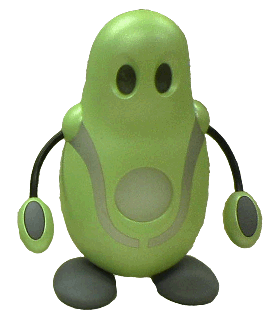Press Information on Attendance
Please send mail to press@iswc.net
to register for a press pass. Television crews may find that the
exhibits, demonstrations, and posters on Monday afternoon and
evening provide the best visuals of the conference, and these
sessions in the program will allow time for interviews. The
gadget show on Tuesday afternoon is an informal presentation of
new technologies and is often a good source of still images.
Flash photography and television crews will not be allowed during
the academic paper sessions so as not to disrupt the
presentations.
Press Release
IEEE International Symposium on Wearable Computers
October 31-November 3, 2004
Washington, D.C.
http://www.iswc.net/ Wearable computing is on the leading edge of mobile and pervasive computing research, spanning a wide range of areas, from fashion design to networking, gaming to medicine. The wearable computing industry has expanded in the US, Europe and Asia, with wearable devices becoming mainstream. Cellular phones, wristwatches, and MP3 players from major manufacturers are now reaching computational functionality once only demonstrated in research laboratories. Specialized wearable computers are addressing niche markets in inventory control, package routing, and even parking tickets issued by the New York police. The IEEE International Symposium on Wearable Computers (ISWC) is the premier conference for wearable computing, bringing together academics, industrialists, military and government officials, and the fashion industry to discuss the latest research results, demonstrate their latest gadgets, and exhibit current products. The eighth annual ISWC will be held October 31-November 3, 2004 in Arlington, Virginia. Located near Washington, DC, this year's conference promises to build rapport with the military and other federal agencies who are exploring wearable computing. ISWC will be co-located with the International Symposium on Mixed and Augmented Reality, which runs November 2-5. The two conferences will have joint sessions on November 3, including a panel session of program managers from government agencies. The projects to be presented and demonstrated at ISWC 2004 cover a range of wearable computing issues, from human computer interfaces to novel applications. For example, EyeGuide is a device for obtaining private information from a public display. EyeGuide whispers verbal instructions to the user to guide the user's eyes to the required information.

EyeGuide. Photo courtesy of Marc Eaddy, Columbia University.
Researchers at Panasonic have studied user preferences for several
types of interfaces for notifying the user of events, including the
personal mascot pictured below. Among their several findings, they
found that, given two devices with the same functionality, users tend
to prefer the one that can be personalized.

Personal mascot interface. Photo courtesy of Vlaho Kostov, Panasonic.
WHYRE is a system intended for use in museums and archeological sites,
allowing users to obtain information interactively as they move through
the area of interest.

WHYRE at the archeological site of Pompeii. Photo courtesy of Pasquale Sorrentino, Ducati Sistemi and Soprintendenza Archeologica di Pompei.
At Osaka University, researchers have implemented a wearable system for
use by a pit crew at motorcycle endurance races, allowing the crew to
have hands-free access to real-time information about the current race
situation.

Wearable computer for a motorbike race pit crew. Photo courtesy of Masakazu Miyamae, Osaka University.
The above projects are a small sample of the ISWC 2004 presentations.
The advance program showing all the research to be presented is
available at http://www.iswc.net,
along with tutorials, exhibits, and research demonstrations.
October 31-November 3, 2004
Washington, D.C.
http://www.iswc.net/ Wearable computing is on the leading edge of mobile and pervasive computing research, spanning a wide range of areas, from fashion design to networking, gaming to medicine. The wearable computing industry has expanded in the US, Europe and Asia, with wearable devices becoming mainstream. Cellular phones, wristwatches, and MP3 players from major manufacturers are now reaching computational functionality once only demonstrated in research laboratories. Specialized wearable computers are addressing niche markets in inventory control, package routing, and even parking tickets issued by the New York police. The IEEE International Symposium on Wearable Computers (ISWC) is the premier conference for wearable computing, bringing together academics, industrialists, military and government officials, and the fashion industry to discuss the latest research results, demonstrate their latest gadgets, and exhibit current products. The eighth annual ISWC will be held October 31-November 3, 2004 in Arlington, Virginia. Located near Washington, DC, this year's conference promises to build rapport with the military and other federal agencies who are exploring wearable computing. ISWC will be co-located with the International Symposium on Mixed and Augmented Reality, which runs November 2-5. The two conferences will have joint sessions on November 3, including a panel session of program managers from government agencies. The projects to be presented and demonstrated at ISWC 2004 cover a range of wearable computing issues, from human computer interfaces to novel applications. For example, EyeGuide is a device for obtaining private information from a public display. EyeGuide whispers verbal instructions to the user to guide the user's eyes to the required information.

EyeGuide. Photo courtesy of Marc Eaddy, Columbia University.
Personal mascot interface. Photo courtesy of Vlaho Kostov, Panasonic.

WHYRE at the archeological site of Pompeii. Photo courtesy of Pasquale Sorrentino, Ducati Sistemi and Soprintendenza Archeologica di Pompei.

Wearable computer for a motorbike race pit crew. Photo courtesy of Masakazu Miyamae, Osaka University.






